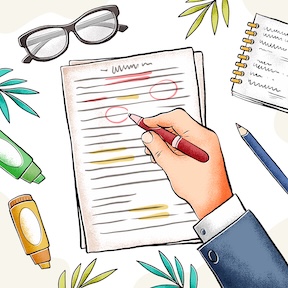Self-editing tips
Many indie authors don’t have unlimited income to hire professional editors. Most are a one-person show: writer, editor, proofreader, publisher and marketer. Not having funds to pay for editing doesn’t mean a manuscript doesn’t need it.
Try these tips to give your blog posts, novels, and short stories a thorough review before publishing.

Use software tools
Unless you’re writing on a typewriter, you have software tools for proofreading right at your fingertips. Google Docs, Microsoft Word, and Pages have built-in software to check spelling and grammar.
It’s also helpful to run work through a third-party software like Grammarly. There is also Grammarly Pro that goes many steps deeper than word processing programs’ software. You can’t rely 100% on any software, but it certainly will find many common errors to help polish your work.
While the tools are valuable, it helps to have a general understanding of grammar so you’ll know when to ignore the suggestions.
There are many things that software will catch that you may not want to change. For example, dialogue. Your characters don’t have to say everything grammatically correct. “Ain’t” isn’t a word, but it is if your character says or thinks it. Also, you don’t have to use complete sentences. Develop your own style and trust it (within reason).
Print your work
If you have the means, print your work to proofread and edit. It’s easier to find mistakes on a printed copy. This is especially so if you print your work in an unusual font or color. Doing this forces your eyes to slow down during reading, which makes it easier to catch mistakes.
Grab yourself a red pen (or any color you prefer) and mark up that manuscript when you find a mistake.
Look for common mistakes
If you want to see some common grammatical mistakes in writing, check out Instagram, Facebook, and X (Twitter).
Misuse of words can be a big pet peeve for readers. It’s helpful to search for each version of the words to make sure they’re used properly. Making word use mistakes is easy to do if you’re in a hurry or writing while tired.
Make sure to use characters’ names correctly and spell them consistently. Readers will notice if a character’s name is spelled differently between chapters.
Avoid overusing filler words or repeating character phrases or actions.
And for the love of Christmas, don’t make something plural by adding an apostrophe +s! And don’t skip the apostrophe when you need to show possession.
Read aloud
Reading your work aloud is a great way to catch mistakes and find problems with rhythm and sentence structure. People read slower when reading aloud, so it’s easier to find mistakes compared to reading silently.
Feel weird doing so? Try reading to pets or using your word processor’s read-aloud feature, which is found under the “Review” section in Microsoft Word.
Enlist beta readers
Having someone else (preferably many someones) read your book before publication is vital. These beta readers are wonderful to point out plot holes or other things that just don’t sit right in your story.
Multiple beta readers can help ensure that your style works to best tell the story. Take what they say into consideration, especially if more than one reader points out something that doesn’t fit. In the end, it’s your story, so you don’t have to make all the changes your betas suggest.
Have editing questions?
Let us know in the comments!
